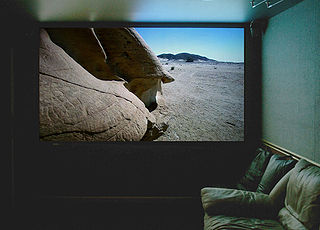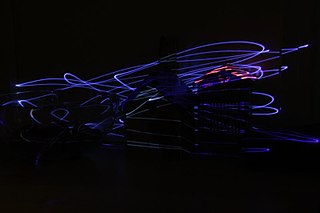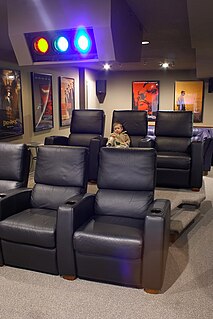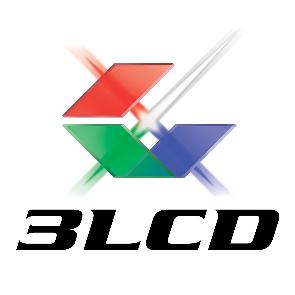
An LCD projector is a type of video projector for displaying video, images or computer data on a screen or other flat surface. It is a modern equivalent of the slide projector or overhead projector. To display images, LCD projectors typically send light from a metal-halide lamp through a prism or series of dichroic filters that separates light to three polysilicon panels – one each for the red, green and blue components of the video signal. As polarized light passes through the panels, individual pixels can be opened to allow light to pass or closed to block the light. The combination of open and closed pixels can produce a wide range of colors and shades in the projected image.

In color reproduction, including computer graphics and photography, the gamut, or color gamut, is a certain complete subset of colors. The most common usage refers to the subset of colors which can be accurately represented in a given circumstance, such as within a given color space or by a certain output device.
Liquid crystal on silicon is a miniaturized reflective active-matrix liquid-crystal display or "microdisplay" using a liquid crystal layer on top of a silicon backplane. It is also referred to as a spatial light modulator. LCoS was initially developed for projection televisions but is now used for wavelength selective switching, structured illumination, near-eye displays and optical pulse shaping. By way of comparison, some LCD projectors use transmissive LCD, allowing light to pass through the liquid crystal.

A video projector is an image projector that receives a video signal and projects the corresponding image on a projection screen using a lens system. Video projectors use a very bright Ultra-high-performance lamp, Xenon arc lamp, LED or solid state blue, RB, RGB or remote fiber optic RGB lasers to provide the illumination required to project the image, and most modern ones can correct any curves, blurriness, and other inconsistencies through manual settings. If a blue laser is used, a phosphor wheel is used to turn blue light into white light, which is also the case with white LEDs. A wheel is used in order to prolong the lifespan of the phosphor, as it is degraded by the heat generated by the laser diode. Remote fiber optic RGB laser racks can be placed far away from the projector, and several racks can be housed in a single, central room. Each projector can use up to two racks, and several monochrome lasers are mounted on each rack, the light of which is mixed and transmitted to the projector booth using optical fibers. Projectors using RB lasers use a blue laser with a phosphor wheel in conjunction with a conventional solid state red laser.

Digital Light Processing (DLP) is a set of chipsets based on optical micro-electro-mechanical technology that uses a digital micromirror device. It was originally developed in 1987 by Larry Hornbeck of Texas Instruments. While the DLP imaging device was invented by Texas Instruments, the first DLP-based projector was introduced by Digital Projection Ltd in 1997. Digital Projection and Texas Instruments were both awarded Emmy Awards in 1998 for the DLP projector technology. DLP is used in a variety of display applications from traditional static displays to interactive displays and also non-traditional embedded applications including medical, security, and industrial uses.

A television set or television receiver, more commonly called the television, TV, TV set, tube, telly, or tele, is a device that combines a tuner, display, and loudspeakers, for the purpose of viewing and hearing television broadcasts, or using it as a computer monitor. Introduced in the late 1920s in mechanical form, television sets became a popular consumer product after World War II in electronic form, using cathode ray tube (CRT) technology. The addition of color to broadcast television after 1953 further increased the popularity of television sets in the 1960s, and an outdoor antenna became a common feature of suburban homes. The ubiquitous television set became the display device for the first recorded media in the 1970s, such as Betamax, VHS and later DVD. It has been used as a display device since the first generation of home computers and dedicated video game consoles in the 1980s. By the early 2010s, flat-panel television incorporating liquid-crystal display (LCD) technology, especially LED-backlit LCD technology, largely replaced CRT and other display technologies. Modern flat panel TVs are typically capable of high-definition display and can also play content from a USB device. By the late 2010s and early 2020s, most flat panel TVs began to offer 4K and 8K resolutions.
The grating light valve (GLV) is a "micro projection" technology which operates using a dynamically adjustable diffraction grating. It competes with other light valve technologies such as Digital Light Processing (DLP) and liquid crystal on silicon (LCoS) for implementation in video projector devices such as rear-projection televisions. The use of microelectromechanical systems (MEMS) in optical applications, which is known as optical MEMS or micro-opto-electro-mechanical structures (MOEMS), has enabled the possibility to combine the mechanical, electrical and optical components in very small scale.

A blue laser is a laser that emits electromagnetic radiation with a wavelength between 360 and 480 nanometers, which the human eye sees as blue or violet.

A virtual retinal display (VRD), also known as a retinal scan display (RSD) or retinal projector (RP), is a display technology that draws a raster display directly onto the retina of the eye. The user sees what appears to be a conventional display floating in space in front of them.

A CRT projector is a video projector that uses a small, high-brightness cathode ray tube as the image generating element. The image is then focused and enlarged onto a screen using a lens kept in front of the CRT face. The first color CRT projectors came out in the early 1950s. Most modern CRT projectors are color and have three separate CRTs, and their own lenses to achieve color images. The red, green and blue portions of the incoming video signal are processed and sent to the respective CRTs whose images are focused by their lenses to achieve the overall picture on the screen. Various designs have made it to production, including the "direct" CRT-lens design, and the Schmidt CRT, which employed a phosphor screen that illuminates a perforated spherical mirror, all within an evacuated "tube."
Fulldome refers to immersive dome-based video display environments. The dome, horizontal or tilted, is filled with real-time (interactive) or pre-rendered (linear) computer animations, live capture images, or composited environments.
Laser color television, or laser color video display utilizes two or more individually modulated optical (laser) rays of different colors to produce a combined spot that is scanned and projected across the image plane by a polygon-mirror system or less effectively by optoelectronic means to produce a color-television display. The systems work either by scanning the entire picture a dot at a time and modulating the laser directly at high frequency, much like the electron beams in a cathode ray tube, or by optically spreading and then modulating the laser and scanning a line at a time, the line itself being modulated in much the same way as with digital light processing (DLP).

Large-screen television technology developed rapidly in the late 1990s and 2000s. Prior to the development of thin-screen technologies, rear-projection television was standard for larger displays, and jumbotron, a non-projection video display technology, was used at stadiums and concerts. Various thin-screen technologies are being developed, but only liquid crystal display (LCD), plasma display (PDP) and Digital Light Processing (DLP) have been publicly released. Recent technologies like organic light-emitting diode (OLED) as well as not-yet-released technologies like surface-conduction electron-emitter display (SED) or field emission display (FED) are in development to replace earlier flat-screen technologies in picture quality.
An electronic visual display, informally a screen, is a display device for presentation of images, text, or video transmitted electronically, without producing a permanent record. Electronic visual displays include television sets, computer monitors, and digital signage. By the above definition, an overhead projector could reasonably be considered an electronic visual display since it is a display device for the presentation of an images, plain text, or video transmitted electronically without producing a permanent record. They are also ubiquitous in mobile computing applications like tablet computers, smartphones, and information appliances.

3LCD is the name and brand of a major LCD projection color image generation technology used in modern digital projectors. 3LCD technology was developed and refined by Japanese imaging company Epson in the 1980s and was first licensed for use in projectors in 1988. In January 1989, Epson launched its first 3LCD projector, the VPJ-700.

The MicroTiles video display system from Christie Digital is composed of modular 16" × 12" rear projection cube units that can be built together into a large video wall-style display. Each MicroTile unit contains a short-throw projector based on an LED light source and DLP optical imaging. The picture is formed onto the detachable front screen surface.
The Samsung i8520 is a projector-enabled smartphone produced by Samsung. Its main feature is a built-in DLP WVGA projector that is able to project images at up to 50 inches (1,300 mm) in size at 15 lumens. The i8520 also contains an 8-megapixel camera, that can be used along with the projector to allow the user to project directly what is in front of the camera. The camera is also able to record HD video at a resolution of 720p at 30 frame/s. The phone also offers local Wi-Fi connectivity, e-mail, and web browsing, as well as containing a built-in GPS receiver. It was released initially in Singapore on 17 July 2010 with the carrier StarHub.
The Qumi (DPC74A1) is a pocket projector manufactured by Delta Electronics for vendor Vivitek. It was released in May 2011.
A projector phone is a mobile phone that contains a built-in pico projector.

MicroVision, Inc. is an American company that develops laser scanning technology for projection, 3D sensing, and image capture. MicroVision's display technology uses a micro-electrical mechanical systems (MEMS) scanning mirror with red, green, blue, and infrared lasers, optics and electronics to project and/or capture images. The company licenses its products primarily to original equipment manufacturers (OEMs) such as STMicroelectronics.














